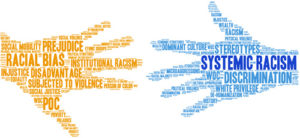It is a universal truth that human beings are visual creatures. If we can see a problem, there is a much greater likelihood that we can understand the root causes and find solutions. Unfortunately, many of the complex challenges we face in our society and in higher education are not easily visualized.
Enrollment and graduation data tell us that students are being lost between those two points, but they do not provide a clear picture of what the specific barriers to success are and how to address them.
Another thing the data confirms is that students of color, particularly Black and Latinx students, are still graduating at lower rates than their white counterparts. While systemic racism has come to the forefront of the national conversation over the last year, do we know how to identify it in our own institutions? What does systemic racism look like?
If asked to visualize racism, you might imagine a person in a white hood, someone wearing a swastika, or a million other images that are easily accessible but difficult to forget. Systemic racism, however, stems from flaws in systems, not people, and it often exists without any malice or ill intent from the individuals who are part of those systems. It is harder to visualize, and therefore, harder to understand. This fact plagues postsecondary leaders committed to equitable student outcomes. If it is hard to see systemic racism, how do they find and fix it?
It may come as a surprise that technology can help with this problem. It is difficult to visualize systemic racism because it is difficult to visualize systems, in general. Using visual mapping technology, supported by an understanding of the systems theory behind that technology, it is possible to create a visual of any system, from an institution’s developmental education approach to its academic advising model. If done right, creating a visual of a system can allow people to see the system, in a very literal sense, and thereby root out and address the systemic racism that exists within it.
To do this work correctly, there are two fundamental steps, which we describe using the example of mapping developmental education course sequences.
Step 1: Visualize the system. What is the structure that has been designed and implemented by the institution? Is it intuitive from a student and faculty perspective or is it unnecessarily complicated? In the case of developmental education, this visual would show all the developmental courses on the books, what the criteria are for students to place into each, and how the courses flow to other developmental courses and eventually lead to college-level coursework.
Step 2: Analyze student progression within the system. How are students moving through the structure an institution has built? Where do they stall? Where do they exit? How does that differ by race? In our developmental education example, an institution might discover findings like:
• Students of color are much more likely than white students to be placed in developmental education courses, even given similar admissions characteristics.
• Students who take developmental education courses tend not to take the subsequent math courses they need for their degree.
• Certain courses have significantly higher percentages of students of color stopping out after taking them, compared to institutional averages.
• Students are not following the prescribed developmental education pathways. White students are more likely to skip steps without repercussion while students of color are more likely to complete extra steps without realizing they weren’t needed.
When campus leaders and all affected stakeholders can visualize, simply and intuitively, these systemic flaws that perpetuate inequities, it becomes much easier to fix them. It is said a picture is worth a thousand words. In our experience, a picture is worth a thousand words, a thousand webinars, a thousand research papers, and a thousand good intentions. To fix systemic racism, we must see it, and through these kinds of technology solutions, we can.
